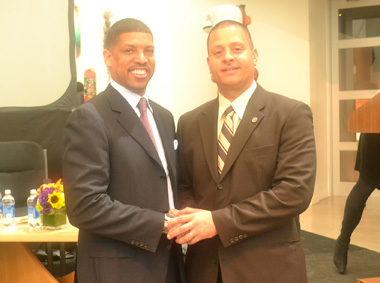 The theme for the Los Angeles Urban League’s Spring Symposium was “Place-Based Neighborhood Change: Successes, Challenges, and Opportunities” which focused on how lives can be improved one neighborhood at a time. Held on Monday at the California African American Museum, this event brought together some of the most experienced and dedicated community activists and organizations.
The theme for the Los Angeles Urban League’s Spring Symposium was “Place-Based Neighborhood Change: Successes, Challenges, and Opportunities” which focused on how lives can be improved one neighborhood at a time. Held on Monday at the California African American Museum, this event brought together some of the most experienced and dedicated community activists and organizations.
Blair Taylor, President of the Los Angeles Urban League, spoke about the importance of coming together to share ideas and not losing sight of the task of improving the lives of underserved communities.
Ed Dandridge led the first plenary session entitled “2011 State of Black Los Angeles Report and the Healthy Neighborhood Index.” Dandridge is the Senior Vice President and Chief Communications Officer for The Nielsen Company. He discussed how some data collected by Nielsen could help organizations target specific neighborhoods, which could help close the technology gap for lower-income families.
According to the report, Black Angelenos have made some progress. Over the last five years, both the Education and Health Indexes increased by five percentage points. The Employment Index also rose by four points. There was no change in the Criminal Justice Index, which remained at 70 percent. Still, the overall index shows that results for Black residents are only 71 percent of White residents. It concluded that even with increased funding to South Los Angeles, Black residents still face grave challenges in the work force, criminal justice system, housing and education. The Report also predicted that if index gains continue at their current rate, it will take 100 years to close the equality gap between African-American Angelenos and other races.
Place-based neighborhood change was the focus of the second session, led by Don Howard of the Bridgespan Group. They played videos that highlighted how neighborhood transformation can be achieved.
L.A. Urban League was noted for its involvement at Crenshaw High School and the 70 blocks surrounding the school. In the last three years, LAUL says crime in the neighborhood decreased by 25 percent and Crenshaw’s graduation increased by 58 percent.
Los Angeles Mayor Antonio Villaraigosa introduced Sacramento Mayor Kevin Johnson, the keynote speaker. Johnson spoke of the work he is doing in Sacramento, saying he uses Los Angeles as a model.
Johnson made a plea for encouraging this generation of children, saying they are struggling due to lack of encouragement, support or guidance. He challenged the attendees to help others and be willing to make sacrifices, like those of the Civil Rights era.
In the afternoon, the group divided into breakout sessions focusing on education, health, safety, workforce and economic development and collaborative partnerships. Each session had a panel of experts who spoke of the work they were doing and discussed strategies and challenges they faced.
The event was sponsored by The California Endowment, the Weingart Foundation, the James Irvine Foundation, The Nielsen Company, FedEx and the Los Angeles Urban League.














